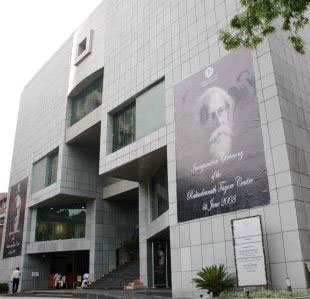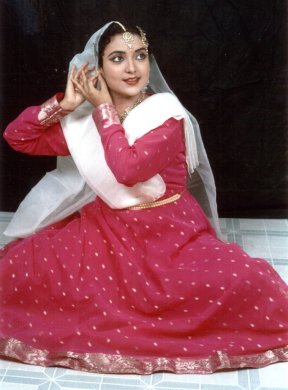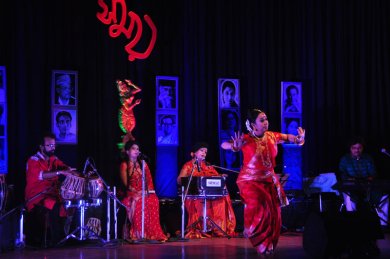
|   |

|   |
 e-mail: ukb7@rediffmail.com Housing tradition and innovation November 29, 2017 In the closing years of the last century, one almost despaired of finding the eastern region artistes in the empanelled lists of ICCR. This was not so much for lack of guidance from gurus or absence of talents as such, as for want of performance space where the youthful skills in music, dance and all other arts could be honed for their full flowering. Even theatre suffered from the same handicap, which appears to be considerably redressed in the new century. One of the glittering facilities that played a significant role in this opening up is that of ICCR itself, making available nearly 3,500 sq. m. of brand-new space in downtown area for Kolkata's cultural efflorescence exactly a decade ago. Initially designed by the redoubtable Charles Correa, the four-storey, glass-empanelled, architectural marvel - with a complex of multiple art galleries, court spaces, green rooms, seminar rooms, projection room, library, café and, above all, a 375-seat auditorium with superb acoustics and décor, has successfully emerged today as a location and a platform for exchange of cultural insights, of sharing of artistic and aesthetic views, and as a venue for the meeting of minds from across the country and overseas, even accommodating an active organ on indigenous arts and crafts of Bengal.  ICCR Kolkata ICCR's own Horizon Series for budding artistes has gathered vigorous force, as exemplified by the recent Kathak performance of Sucharita Dutta. Groomed in Bharatanatyam by Thankamani Kutty and Kalamandalam Venkitt, and then in Jaipur Gharana of Kathak by Amita Dutt and Susmita Mitra, Sucharita is a gold-medalist from Rabindra-Bharati University, having done doctoral research in the manifestation of Kathak in Rajput and Pahadi miniature paintings. Having accompanied Pt. Birju Maharaj and Saswati Sen in some of their all-India tours as Radha in Gita Govinda, she seemed to be a right choice to be encouraged by ICCR.  Sucharita Dutta After an overture in raga Yaman and a reposeful Shiva Stuti, Om namah Shivaya... in raga Darbari Kanada, Sucharita began technical Kathak of Dhamar in 14-beats. Her right royal stances in thaat, her upaj with quick-silver tihais, her majestic aamads and uthaans, her chakkars, her padhant and her parmelus - with both tabla and pakhawaj mnemonics - - were all a visual treat. Gracefully transiting to a thumri, she regaled the viewers emoting with the lyric, Mori gagaria kahe ko todi re Shyam... Reverting back to traditional Kathak of Jaipur Gharana, she demonstrated some drut teentaal in anaagat mode. Then in the true blue Birju Maharaj style, she played with quite a few short-breath and long-breath tihais. When accosted later, she remonstrated, "Who else could you follow but Maharaj-ji?" Sucharita concluded with four picturesque chakkars, which she had aptly named Brahma Chakkars after Brahma's four faces! She was ably accompanied by Dinesh Pal on vocal, Samdip Niyogi on sitar and Debashis on sarangi.  Samay Not to be confined to only sponsored artistes, ICCR has also opened its doors to let performers experiment with new genres. This was recently illustrated by Samay (Time), presented by Lahari. Choreographed by Prakriti Basu, here was an effort to pay a tribute to the ageless Bengali melodies that flourished through the 60s, the 70s and the 80s - visualised through innovative dance. Prakriti too was trained by Thankamani Kutty and later by Tanusree Shankar and Taniya Diwanji, and finally - after an interregnum of marital bliss of sixteen long years - she returned to the scene, determined to carve a new niche for herself. The programme touched off with five songs of Tagore, rendered by the mother-daughter duo, Deepabali Dutta and Ratnabali Rudra Dutta. The first three were almost invocatory in nature: Waves of bliss pervade the cosmos..., O the vernal, charmer of universe... (modelled on the melody of Meenakshi me mudam... by Dikshitar) and The soul brims over in your grace... The fourth was a patriotic song: Wretched and hapless, you're in bondage day and night... (derived from an original melody, also rendered) and the fifth a devotional song from the operatic play Valmiki Pratibha: Call out to Goddess Kali today, victory to her... (derived from an Irish ballad, also sung). The first three were interpreted in Bharatanatyam by Sucharita (who needs to watch out on her avoirdupois) and the last two by Sujit Karmakar in Kathak. Gargi Ghosh in vocal and Debashis Basu in narration then took over the sojourn of over a dozen perennially favourite songs through time, accompanied by the traipsing feet of - besides Sucharita in Bharanatyam, creative and folk - - Shatabdi Bhoumik (trained in Kathak and creative), Sujit Karmakar (also with background of Kathak) and Shouvik Bhattacharya (groomed in Bharatanatyam), not to forget the little Araina Karmakar, taught dance by her loving father. The choreography liberally blended the gesture language of Bharatanatyam, stances and pirouettes of Kathak, and balletic balances and extensions of creative dance - - with the folk idioms of highly contagious swaying and pulsating beats of Bengal's Jhumur, Assam's Bihu and Rajasthan's Ghumar, suiting the mood of each song. The bouquet of Bengali lyrics comprised: In the glow of glass bangles... (1958) (interpreted in Ghumar), The turbulent cyclone... (1958), The bewitching clouds lent slumber... (1962) (interpreted in Jhumur), O my mind, who knows, when life begins or ebbs away...(1969), Pa Pa Ma Ga Re Sa... (1971), O butterfly, O butterfly, give wings to my desires...(1971), The one who does not fathom love's many moods... (1971), Mahua wine intoxicates me no end... (1974) (interpreted in Bihu), You were then sweet twenty- one...(1976), Taader den ta tum na tum...(1977) (dancing steps by little Araina), Near about the month of Paush...(1982), Wind and clouds make all the blooms drop down... (1978) and the Satyajit Ray gem: O what a bliss pervades the sky and the air... (1980) (interpreted by all five dancers together). The popularity of the colourful songs can be gauged from the fact that most of them were set to tune by masters like Salil Choudhury, RD Burman and others, and rendered originally by celebrities like Lata Mangeshkar, Asha Bhonsle, Geeta Dutt, Hemanta Mukherjee, Manna Dey, et. al. The choreography - whether in classical, creative or folk idioms - - aimed at creating what Tagore had termed "mood dance" approximating to the shades of meaning and nuances of the libretto. It was a worthwhile effort on the whole, bound to gain finesse with time. Kudos to ICCR for lending its platform to such a venture!  Dr. Utpal K Banerjee is a scholar-commentator on performing arts over last four decades. He has authored 23 books on Indian art and culture, and 10 on Tagore studies. He served IGNCA as National Project Director, was a Tagore Research Scholar and is recipient of Padma Shri. Post your comments Please provide your name and email id when you use the Anonymous profile in the blog to post a comment. All appropriate comments posted with name & email id in the blog will also be featured in the site. |